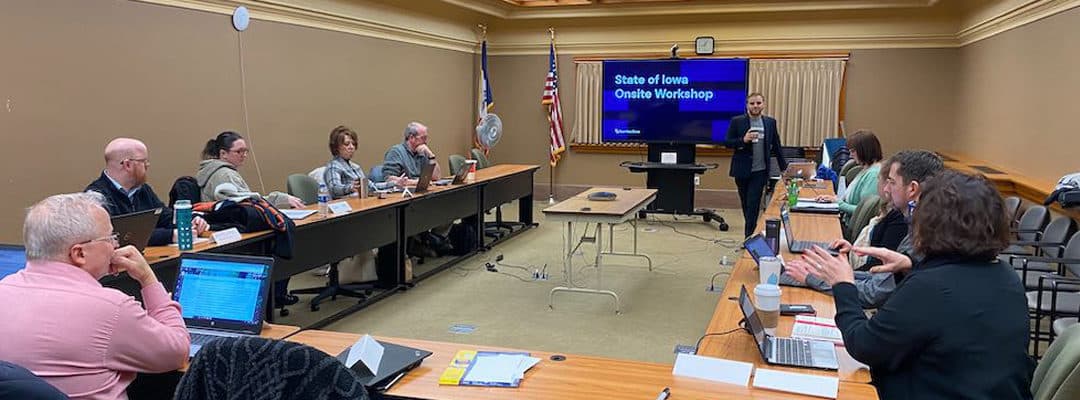Our ‘Local Government Best Practices’ series profiles innovators in the public sector who are bringing digital transformation to their municipality.
On August 12th we spoke with Jonathan Feldman of Asheville, NC to learn more about what his team has done to respond to the COVID pandemic. In this article, you can listen to his interview in the audio clip, or read the transcription.
Karl Pawlewicz (KP): Today we have the distinct honor of talking to Jonathan Feldman, who is the CIO for Asheville, North Carolina today. Jonathan, I’ve heard that there is a lot of good stuff that’s happening in Asheville these days. Before we dive in on some of the key learnings that you’ve gathered over the last few months, perhaps you can give our listeners just a little bit of information about who you are and what you’re doing there in Asheville.
Jonathan Feldman (JF): Absolutely. I’ve been in IT longer than I care to admit and we don’t have to actually talk about that number because that would make me seem old. But I’ve been with Asheville, North Carolina 15 years and we have really developed the team to punch way beyond the weight class of Asheville. I’m very proud of the team. They’ve done a lot of awesome things.
KP: How large is your municipality?
JF: Asheville has about 100,000 people in it. Our daytime population pre COVID used to swell by about 20,000 or 30,000 during the day because a lot of folks in the greater region and that’s about 300,000 come in to Asheville every day to work in play.
Asheville is nestled in the Blue Ridge Mountains and we are very fortunate to have a wonderful climate and a lot of things to do, including craft brew and paddling and hiking and biking and the blue Ridge Parkway coming right through. I feel very lucky to live here.
We cover about a 43 square mile area and we do everything from radio telecommunications for our public safety officers to managing financial systems, just like a normal IT organization does. We also manage our help desk, and our ERP and GIS, which of course is one of local governments keystone applications. So that’s geographic information systems and everything in between.
KP: You and your team – like so many of us – have had a year unlike any other. How has your team responded to some of the challenges that have been thrown our way so far this year?
JF: The biggest thing Karl is that we have learned that modernizing our infrastructure before COVID hit was a really good idea. And what do I mean by modernization? I mean that staff has been really open for the most part to this notion of, “Hey, we only have 1300 employees. Should we be doing everything on premise? Probably not.” “Should we have this big server room? Well, maybe not.”
Getting to a place where the entirety of the productivity application portfolio was in the cloud happened in 2017. I think that was probably the most helpful thing that happened because it meant that when COVID hit, we didn’t say to people, “Oh gosh, we’ve got to upgrade our VPN concentrator. You know, just like it’s 1999” Instead we said, “Well, just go home and work.”
When you think about that, that’s incredibly powerful because when you’re using a modern application portfolio and I don’t care whether you use Office365 or Google—when it’s modernized, it has end to end encryption. You don’t have to buy that. That’s built in, you don’t have to worry about two factor authentication it’s built in. And so you don’t have all these bolt-ons and this degree of complexity that you would, if you hadn’t modernized and you were still hosting a server on premises and saying, “Oh gosh, we’ve got to somehow deal with desktop clients and all that kind of stuff.”
So the biggest ‘AHA!’ moment we had was thank God we did that because it would have been a lot uglier.
And when we talked to our peers, and when business leaders at the city talked to their peers, that’s exactly what happened for a lot of other organizations that had to upgrade everything in four weeks. For us it was great that we didn’t have to do that. So now we are more dedicated than ever to this notion of modernizing.

(Image via Wikimedia Commons)
KP: If there’s a municipality that maybe he got caught flat footed by this pandemic, can you offer any thoughts on how to prioritize that list of things to do?
JF: I first want to make it super clear that I’m not demonizing any organization that’s not been able to modernize their application portfolio because that requires a lot of management support. It requires finance support. It requires cooperation from departments. It’s a very multifactorial type of effort and it’s not easy.
In Asheville, we were extremely fortunate that all of those stars aligned. What I would say is if you’re starting today or you’re saying to yourself, “Okay, that’s it, we’re going to modernize” the biggest thing, because of that multifactorial necessity, is that you really need to make sure, every day, that IT is viewed as a credible organization.
Because, as it turns out, you need a whole lot of trust from folks like finance, or city management departments before they’re going to let you change anything, and changing the status quo is generally what modernization is all about.
I think just getting a clear picture in your mind, how it is going to establish and maintain and continue IT’s credibility is the most important thing about that modernization journey. And let me also suggest that the way that we have achieved that credibility is by putting the customer front and center, but also acknowledging that nothing great for customers is ever done on the backs of employees.
KP: Can you expand on that idea of nothing great is ever done for customers on the backs of employees?
JF: As it turns out, miserable employees render miserable service. And if you expect that you’re just going to whip and chain IT employees into being able to render superior customer service and really care about the customer, you got another thought coming, right?
So that’s the relationship. One of our core values in IT services is that we recognize the relationship between an employee’s quality of life and their quality of service.
KP: Is there any change to the way you’ve done business with your constituents or your employees that has been a really new or eye-opening development for you in the last few months? Something that you think will stick around for years to come now?
JF: For sure this notion of remote work, I think that that’s here to stay. I think that’s here to stay even when COVID is over.
I think IT was already sort of bought into the notion of remote work, because you translate that commute time into productivity time. We were only partially remote before and now we’ve had to learn a lot of things about how to stay connected. We’ve had to establish, for example, a chat room for water cooler kind of chat and that type of thing.
I think city management and others have seen that the departments and folks have been incredibly effective when they work from home. And they can also be in the office when they need to be. I think this fully remote/hybrid system is absolutely here to stay.
I think that some business leaders may try to wish it away because they want to have their thumb on employees. But fundamentally I think successful organizations have realized that when folks are remote, there are a lot of benefits and that instead of judging people by butts in seats, if you judge them by output and objectives and outcomes, you actually make the organization better because you get stuff done.
KP: What are you most excited about to innovate in Asheville in the second half of 2020 and into 2021?
JF: Asheville was in the news recently for reparations and our focus on equity. I’m excited about the role that our data program and our performance management program will play in that. We have a splendid equity director and an equity toolkit that’s intertwined with data transparency and accountability. So I’m very excited about that.
I’m also excited about the greater access for participation in government. We’ve now partnered with our community and public engagement department for fully remote council meetings. We now have fully remote council meetings and the ability for folks to participate in council meetings no matter where they are. For example, if you’re a single mother who is working two jobs and it’s hard for you to come to city hall, you can call and weigh in.
We talk a lot about asynchronous versus synchronous participation in business types of decisions. Our community and public engagement folks have made asynchronous participation a lot more possible and by doing so have given folks who live in our community more options for participation. They don’t have to come to city hall, they can call into the council meeting, because it’s fully remote. And eventually they’ll also be able to come to city hall once we reopen. So I’m excited about both of those things.
KP: Can you give us the quick rundown on the tech stack that you use to make those remote council meetings happen?
JF: We use a public input.com for our engagement hub. We use YouTube as the means of broadcasting meetings, whether it’s boards and commissions meetings, or a formal council meeting. And all of our remote teleconferencing is done through Google Meet.
KP: You mentioned the role IT will play in terms of data aggregation for reparations and information sharing throughout the municipality. Is there any other role that IT will play in that process as it gets underway?
JF: We’re still kind of midstream with some of this, so I don’t want to get ahead of ourselves, but I’m pretty sure that we’ll be doing a lot of data gathering. I think SeamlessDocs is going to play a role, most likely in terms of the data gathering that we’re going to be doing with the community.
We have a city manager who is committed to transparency with our data program, and so IT will be at the center of that because you have to not only gather data, you then have to actually share the data that can be shared. Not personnel records or investigation files and those kinds of things, but the stuff that by law we are allowed to share. That will be a big, big lift. It’s a big role, but it’s also one that we’re really excited about.
KP: On that topic of data gathering, Asheville has also been working through the grant applications programs that have been made available to local businesses there. Can you talk a little bit about how that process has gone?
JF: One pretty successful initiative was the one Buncombe County fund that the City of Asheville participated in.
Because it was really more of a regional type of grant process the City and the County were able to partner and manage the program to help local businesses. I thought it was a great example of how government agencies can collaborate and create good in the community.
KP: Any feedback from the community, success stories, or any anecdotes that you can share?
JF: You’ll notice there’s a theme in partnership in a lot of what we talk about and it’s not by accident. We’ve partnered with human resources, we’ve partnered with the city manager’s office, we’ve partnered with finance to make contracts route without people needing paper.
Our human resources department has partnered with us to use technology to keep everyone in the loop every week. They’ve also done a good job providing content because of course we can provide the technology, but then there has to be good content.
Everything from SeamlessDocs, to Google Meet, to ZScaler that we use to give folks easy access to our ERP—all of that stuff again was in place before we ever heard about COVID. That meant a lot of our efforts during the pandemic have been on making it easier for our employees to do what they need to do, rather than deployment. Our time has been more focused on getting employees the gear they need to work from home.
Or, another example: We partnered with Facilities to create a system to regulate how many employees are coming into the office each day, because we don’t want too many people in the building at once. And a system to limit the number of employees who can board an elevator at the same time. That was really early, when no one knew anything, but because we had our fundamentals down, we were able to think a bit more broadly about how we can optimize this for our employees and that went a long way.
KP: Do you have any parting words of wisdom or encouragement for your counterparts who are out there as we try to get through this together?

JF: These are going to stay in the gray for a while. I think we’re not going to have certainty. IT Folks always want deterministic systems. Well, except for Ethernet, but we always want things that are predictable.
A lot of folks in IT are very concrete, very sequential. If you’re a coder, you really want to know everything’s laid out just so, and I think the hardest thing for it folks is that we don’t have a lot of certainty. We don’t have certainty about when is COVID going to be over, or when there’s going to be a vaccine, or when will civil unrest stop. All of those things make things extremely difficult to predict or plan for.
What I’ve been saying to my staff, and I would repeat to any IT professional out there is that we’ve got to get adjusted to the new normal. Just because there are crises does not mean that there is no plan. Because there is a plan and hopefully your IT organization has a business plan.
To that end, I think we need to be flexible and understand when we’re working on the plan…and when we’re working on the crises, and how do the crises affect the plan and how DON’T the crises affect the plan.
People need to acknowledge that there’s a great deal of uncertainty, but also acknowledge that there are some things that we can have impact on and just find a path forward.
For follow-up questions, you can connect with Jonathan on LinkedIn or Twitter.


